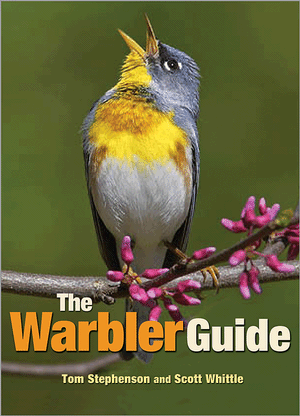 This is a guide to the 56 warbler species of the USA and Canada.
This is a guide to the 56 warbler species of the USA and Canada.
You might think that there is hardly any need for a guide to a group of birds that are so patterned, so marked, so coloured and so …well, obvious! But there is, because they are quite confusing.
The Peterson Guide has a famous plate called ‘confusing fall warblers’ because they are! This book will help you identify males and females, young and old and spring and fall (or even autumn) plumages of this marvellous group of birds.
The whole book has a refreshingly fresh approach. The authors and illustrator have put a lot of thought into how really to help us identify these birds. This is definitely not ‘just another field guide’. It has a quiz at the back of the book to see whether you have assimilated any of the wisdom of the first 500+ pages.
The several pages of ‘Quick Finders’ are very good. These group images of all relevant warblers for easy comparisons so that you don’t have to do that thing of flicking from page to page to page. Some are geographic (eg eastern fall warblers), some are anatomical (faces – surprisingly useful, I think) and some are arranged by view (the 45 degree views from underneath are very useful – reflecting, as they do, a very usual way of seeing these birds up in the foliage).
There are masses of photographs – for example for mourning warbler there are 27 photographs of the bird from different angles etc and six more on the same pages of ‘comparison species’. This is just what you need.
Catherine Hamilton’s drawings are a great help too.
I used to be quite accustomed to ‘reading’ sonograms and making sense of them but I just wonder whether the space given over to them will help many of us to distinguish these birds by song and call. Maybe it will. I’d make sure you take some calls with you on your mobile phone so that you can literally compare notes in the field.
Americans are very keen on mnemonics for songs and there are some brilliant ones here (although whether they will actually help you in the field I am not convinced). For example the parula song is: ‘Parula is a jeweler, her rough necklaces rise up and snap at the top’ whereas Wilson’s is: ‘Pres Wilson started out strong but fell, gradually, due to repetitive policies’. A lot of thought has gone into these and some are quite memorably funny.
Some of the photographs are just stunningly beautiful – because these are cracking birds. Full page images of a few species are simply gorgeous. Take the northern parula on the cover – one of my favourite American warblers – as an example.
It’s hardly a pocket guide, and to lug it around when it won’t help you identify shorebirds, sparrows or flycatchers in the field, might make it a bit of a luxury. But if I could spend my life looking at spring warblers in the USA and Canada I’d be a happy man. For the ‘Big Week’ at Magee Marsh I would want this book at my side. There are apps associated with the book too, and I haven’t looked at the ebook but that might well be an easy way to carry this around – you’d want it in colour though, for sure. And I guess that it could come in very handy on Scilly or Fair Isle in the next few weeks – maybe? Who knows?
As you stare up into the branches, getting ‘warbler neck’, this book will ease the pain.
The warbler guide, is published by Princeton University Press and is available on Amazon as is Mark Avery’s book Fighting for Birds.
[registration_form]
Hmmm.
I’d be far more interested in any book review which sheds some light on the cisticolidae of Guinea-Bissau.
Any chance Mark?
Doug – I have been rather patchy about taking advice through my life. As a school boy I was told that there was work to be done working out the African cisticolas – I have never regretted not acting upon that advice.
Aw shucks.
I like the approach of Leo Kottke – world renowned fingerstyle guitarist and myrmicophile – to book reviewing. “They’re only similar because they are in the same book”.
Ian Peters may like this: https://www.youtube.com/watch?v=uk88Iyw-CJE